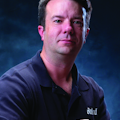• What kind of temperature sensing do I have? One of the first things you need to do is identify and become familiar with the type of temperature sensing your imager employs. There are bar-graph displays that indicate the intensity of the temperature by moving a graphical indicator vertically along a temperature bar and there are digital readouts that display a number in the upper-right or lower-left of the display area. Some imagers use both types of display simultaneously.
There are pros and cons to both types of displays. A bar-graph indicator tends to provide a better "impression" in the mind of a firefighter as to approximate temperature levels. Given the inaccuracies we discussed last month, many fire departments prefer the generality of the bar-graph display, since most do not see temperature sensing as an important or overly valuable feature. On the flip side, however, some departments dislike bar-graph-only displays for this very reason. Some fire departments feel the bar-graph display lacks specificity and prefer something more concrete like a displayed number.
• How should I use it? This becomes the big question. Temperature sensing is inherently inaccurate, even under laboratory conditions. Add in the variables of a typical fire scene and these inaccuracies can become exacerbated to the point of making the information totally useless. Given all of this, is there any way that temperature sensing can be employed effectively on a fire scene? The answer is yes. Just like any other piece of equipment, you need to understand the limitations of the technology and then implement it within its intended use.
Temperature sensing is best used when evaluating the temperature differences in the same or similar materials. This means that when performing overhaul, you may use temperature sensing to tell you what portion of drywall is hotter than another portion of drywall, as long as both readings are evaluating drywall. When comparing like materials, the temperature displayed does not matter as much as the difference between the temperatures — the temperature delta. If I look at two different areas of drywall on the same wall and one area measures 50 degrees Fahrenheit hotter than another, then I can assume this delta to be correct; however, I cannot compare the temperature difference between drywall and wood paneling on the same wall as most wood paneling is far more reflective than drywall and will have an effect on the displayed temperature.
Other applications may include the evaluation of different areas of heating duct (again similar materials) or temperature differences in a roof that you are getting ready to ventilate (works best at night so as to eliminate the effects of the sun on the roof temperature). Again, the evaluation of the temperature delta in like materials is the best implementation strategy.
• How can I practice and train? Like anything else, practicing and training are the best methods of incorporating and understanding a skill. There are several ways you can create drills to reinforce the main two points, which are that temperature sensing can be wildly inaccurate and comparing the delta in like materials can be effective.
A decent amount of training on these concepts can be conducted right at the stove in the firehouse. If you have a gas stove, you can readily show that temperature sensing will not account for air temperature by turning the burner on high and positioning the imager low to the burner so that the crosshairs are looking through the flame. The flames themselves will have little effect on the temperature measurement, but if you place a cast-iron skillet on the flame, the skillet will provide a measurable surface.
If you have an electric stove, cover half of the burner with aluminum foil with the more reflective side out, then turn the burner on. After several minutes, you will get a dramatically different temperature reading from the uncovered side than you do from the covered side as seen in the two images on page 44 The aluminum foil is in direct contact with the burner and must be as hot as the burner, yet it displays dramatically differently. This is obviously due to the reflectivity of the aluminum foil.
Another scenario would be to place a small space heater approximately 18 inches behind a closed door and wait several minutes. You can then use the thermal imager to locate temperature differences in different areas of the same door and use that information to direct investigative efforts.
The bottom line to all of this temperature sensing is this: never attempt to replace basic firefighting skills with a thermal imager. If you find yourself crawling down a hallway at 2 A.M. and you are on your belly due to the heat conditions, but you look at the temperature display of your thermal imager and it indicates a temperature of 200°F, don't go back to crawling on your hands and knees.
Temperature sensing is not nearly as accurate as a well-trained firefighter. Always trust training. You can enhance training with thermal imaging, but you can never replace training with a thermal imager.
BRAD HARVEY is the Thermal Imaging Product Manager at Bullard. He is a veteran of public safety as a firefighter, police officer and paramedic and is certified through the Law Enforcement Thermographers' Association (LETA) as a thermal imaging instructor. Harvey has worked as a high-angle rescue instructor and is a certified rescue technician and fire instructor. If you have questions about thermal imaging, you may e-mail him at [email protected].
About the Author
Brad Harvey
BRAD HARVEY is the Thermal Imaging Product Manager at Bullard. He is a veteran of public safety as a firefighter, police officer and paramedic and is certified through the Law Enforcement Thermographers’ Association (LETA) as a thermal imaging instructor. Harvey has worked as a high-angle rescue instructor and is a certified rescue technician and fire instructor. If you have questions about thermal imaging, you may e-mail him at [email protected].
